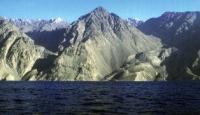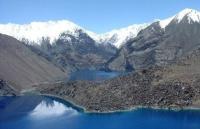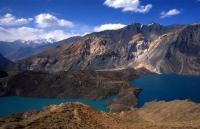You are here
Usoi blockage on Sarez Lake.



Adventure holiday in Tajikistan.
"Kishlak Usoy with all the inhabitants (54 people) was completely buried under the rubble. Three residents of Usoy - Mirshalib Gurgaliyev, Namsit Karamshaev and Sulmamat Karamkhudoev, survived, went on holiday to the village of Sarez, who survived an earthquake, heard the crash and saw the crash a dense curtain of dust that stood over the village of Usoy for several days. Three days later they managed to get to the place of the blockage and see a pile of rock fragments in the place of their native village"
Academician V. Poslavsky.
“We felt a strong push. A few minutes passed - the earth shuddered at two more shocks of the same strength. The entire population of Sarez jumped out of the wagons, which began to collapse with a second push, but there were no human casualties in Sarez.
At this time, rocks near the village of Usoy began to crumble. Instantly a dense curtain of dust rose and hid Usoy from us. Dust over the village stood for several days. Only three days later it became possible to get to the place where Usoy was. There was no trace of the village. Killed all the inhabitants who were in Usoy during the collapse"
Resident of Usoy Mirshoib Gurgaliyev. A story to the topographer O. G. Chistovsky.
City break in Khorog town.
On the night of February 19, 1911, at 11.15 p.m., the slope of a gigantic mountain that rises about three kilometers above the Murghab valley, suddenly budged and with a terrific roar, shaking the earth's crust within the Pamirs and Afghanistan, slipped into the Murghab valley.
This grand collapse was caused by an earthquake. If there was a huge city, no one would ever see it again. And there was only a small poor village of Usoi with a hundred inhabitants, with their pets, with houses made of stones.
Two billion two hundred million cubic meters of stone fell on this village - a thousand cubic meters would be enough for it to disappear without a trace. Six billion tons of rocks formed a wall seven to eight hundred meters high and eight kilometers wide.
The nearest villages Rukhch, Savnob, Pasor, Nisur were destroyed by a concussion, people and cattle were killed in the ruins. The villages of Barchidiv, Sarez, Irkht were badly damaged ... And on the far from here lake Karakul the ice cover opened.
Geologists called this catastrophe Usoi blockage. The clogged high-water river Murgab rested against an almost kilometer wall. Water has passed the whole Pamir, there was nowhere to go. She rose higher, forming a huge lake.
By October 1911, having spilled twenty kilometers, water began to flood and the village of Sarez, spread out on a high terrace. Thirty-two families moved to villages along the Gunt River. Several families headed to the Kudara Valley.
Someone went to Bartang. Mirshoib Gurgaliyev settled in Pasor. The lake spilled farther and farther, swallowed all the crops, gardens, everything that was in the valley. In 1913, Captain G. A. Shpilko, the head of the Pamir Post, made his way to the almost impregnable shores of the lake, examined it and with great difficulty made a topographic survey.
By this time, the length of the lake was twenty-eight kilometers, the average width of about one and a half kilometers, the greatest depth of two hundred and seventy-nine meters. Water all arrived, the lake level increased by thirty-six centimeters daily.
The village of Nisor-Dasht, located on the Murghab River, and the village of Irkht, at the mouth of its tributary, were already flooded. Part of the population of these villages moved to Bartang, some people, rising to the upper reaches of the Irkht River, founded a new small village there.
A deep bay was formed on the site of the former village of Irkht. Captain Shpilko, a local resident, Tajik Niyaz Kabulov, suggested settling in the blockage and constantly monitoring the level of the lake, making marks on eight rails set in different places.
A small house was built for Niyaz Kabulov. The water that arrived in the first year consumed all eight slats, only in the following years the lake level began to rise more slowly. The first information about the lake, called Sarez, penetrated the press.
In the "Turkestan Vedomosti" on November 3, 1913, the message "Expedition to explore Lake Sarez" was published. There was a lot of fiction in this post. Captain G. A. Shpilko published in the same Turkestan Vedomosti a letter to the editor, in which he provided accurate information verified by him.
The following year, Shpilko’s articles were published in the Izvestia of the Russian Geographical Society. In the same year, the Usoi earthquake and its consequences were reported in the "Russian Vedomosti" by the botanist D. D. Bukinich who traveled in the Pamirs, and since 1914, after Shpilko’s article in the Izvestia of the Russian Geographical Society and other messages, the news of a new, phenomenal lake spread around the whole world, they became interested in him, the greatest scientists wrote about him, such as V.N. Weber and L.S. Berg.
Fighting stubbornly against the blockage, the lake water began to seep through the five-kilometer thickness of the dam. In April 1914, filtered pure keys were hammered on its other side. Merging into one stream, they gave birth to a new river - connecting with the Ku glaciers flowing from Tanymas Kudara glaciers, the river again became known as Bartang.
Foamy, seething, cold, it rushed down a winding gorge to merge with the waters of the mighty Panj two hundred kilometers below. One by one, various travelers began to seek the lake. In 1915, having visited the lake, made a new survey and some observations, he returned to Petersburg and made a detailed report on the lake I. A. Preobrazhensky.
His report in the Geographical Society was discussed by the largest scientists: K. I. Bogdanovich, D. I. Mushketov, D. D. Bukinich. Much has been said about the threat of a lake breaking through the dam. But before the October Revolution, apart from some travelers who rushed to the lake at their own peril and risk (and were not always able to reach it), no one else was interested in him.
And the observer Niyaz Kabulov, who was left by the lake, illiterate, not knowledgeable in science, but devoted to the work entrusted to him, continued to note the increase in the level of the lake on new rails for several years.
Water has long washed away the house built for him. He lived in the nearest village and, coming to the obstruction, each time he watched as the surface level of the lake was getting closer to the crest of the obstruction.
Authority:
"Traveling in the Pamirs." Pavel Luknitsky. Publishing House of the Komsomol Central Committee, "Young Guard". 1955.







